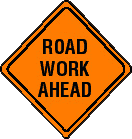Work Zone Accidents
August 4, 2014 | Category: Automobile Accidents | Share As many of us head out on, or return from, vacation using our motor vehicles for transportation, it is important that we be aware of the work zone areas we may encounter on our way. Motorists travelling on the national highway system can expect to encounter roadway work zones, on average, every 100 miles traveled, according to the North Carolina Department of Transportation Work Zone Safety Program Safety Fact Sheet.
As many of us head out on, or return from, vacation using our motor vehicles for transportation, it is important that we be aware of the work zone areas we may encounter on our way. Motorists travelling on the national highway system can expect to encounter roadway work zones, on average, every 100 miles traveled, according to the North Carolina Department of Transportation Work Zone Safety Program Safety Fact Sheet.
Roadway work zones are hazardous both for motorists who drive through the complex array of signs, barrels, and lane changes and for workers who build, repair, and maintain our nation’s streets, bridges, and highways.
The congestion on our roads is growing, along with the increasing need to maintain and reconstruct existing roads already carrying traffic. Urban and suburban growth also require that new roads be built and existing roads be reconfigured to accommodate the new roads. Maintaining work zone safety and mobility are challenging under these conditions.
Florida was ranked as one of the three top states with the most motor vehicle crash fatalities in construction and maintenance work zones in 2012 with 50 deaths. Nationwide, fatalities in construction and maintenance work zones of both workers and motorists, reached 609 in 2012. These are the latest available figures from the CDC (Centers for Disease Control & Prevention).
The U.S. Department of Transportation - Federal Highway Administration (FHA), reports the most common accidents in work zone areas are rear end collisions. In their brochure titled: Creating Safer Work Zones: Improving Operations On Both Sides Of The Barrel (2012), they list the following "Facts":
- During the past 5 years in work zone crashes more than:
- 4,400 persons died (85 percent of which were the driver or passenger)
- 200,000 persons were injured
- Drivers are the most frequent fatality in work zone crashes
- Most work zone fatalities involve working-age adults
- Rear-end crashes (running into the rear of a slowing or stopping vehicle) are the most common type of work zone crash.
- Fatal work zone crashes occur most often in summer and fall.
- The majority of fatal work zone crashes occurred on roads with speed limits greater than 50 mph.
- Stopping distance for motor vehicles at 50 mph:
- Dry roadway~300 ft
- Wet roadway~400 ft
- Icy pavement~1250 ft
- A loaded 80,000 lb. tractor-trailer requires almost 50% more stopping distance.
- It takes only an extra 25 seconds to cover 1 mile at 45 mph compared to 65 mph.
Nearly all states have laws that increase the penalties for speeding or committing other traffic violations while in a construction work zone. Florida is one of the states that doubles the original speeding fine if speeding in a work zone.
Road construction crews use signing, roadway markings and flaggers to direct drivers safely through work zones. They also, on occasion, provide marked detours. Motorists are responsible for knowing how to read and react to these directions. Driving cautiously and courteously, along with paying attention, are important steps in preventing work zone accidents.
The FHA further provides these safety tips for drivers who many encounter work zones:
Stay Alert and Minimize Distractions
- Dedicate your full attention to the roadway.
- Avoid changing the radio station, using a mobile phone, eating, or other distractions that can remove your concentration from the road.
Keep Your Headlights On
Pay Attention to the Road
- "Listen to the signs". (If you hear loud, machinery-type, sounds, this is a sign that road workers are probably nearby.)
- Watch brake lights on vehicles ahead.
- Watch traffic around you and be prepared to react.
Merge into the Proper Lane
- Merge well before you reach the lane closure.
- Be aware that traffic patterns can change daily.
Don't tailgate
- Follow other vehicles at a safe distance.
Obey the Posted Speed Limit
- Workers may be present just feet away.
- Fines may be doubled for moving traffic violations.
- Be prepared to slow down further if conditions indicate the need.
Change Lanes Safely
- Change lanes only where pavement markings indicate, and only when traffic conditions permit.
Follow Instructions from Flaggers
Expect the Unexpected
- Workers, work vehicles, or equipment may enter your lane without warning.
- Other vehicles may slow, stop, or change lanes unexpectedly.
Be Patient
"There are resources motorists can access that will provide up-to-date information on where there may be road work underway. The FDOT (Florida Department of Transportation) has this information on their website listed by county. You may access the information from this link," says Motor Vehicle Accident Attorney, Randall Spivey of Spivey Law Firm, Personal Injury Attorneys, P.A.
Florida Accident Attorney, Randall L. Spivey is a Board Certified Trial Attorney – the highest recognition for competence bestowed by the Florida Bar and a distinction earned by just one (1%) percent of Florida attorneys. He has handled over 2,000 personal injury and wrongful death cases throughout Florida. For a free and confidential consultation to discuss your legal rights, contact the Spivey Law Firm, Personal Injury Attorneys, P.A., in Lee County at 239.337.7483 or toll free at 1.888.477.4839,or by email to Randall@SpiveyLaw.com. Visit SpiveyLaw.com for more information. You can contact Spivey Law Firm, Personal Injury Attorneys, P.A.in Charlotte County at 941.764.7748 and in Collier County 239.793.7748.

